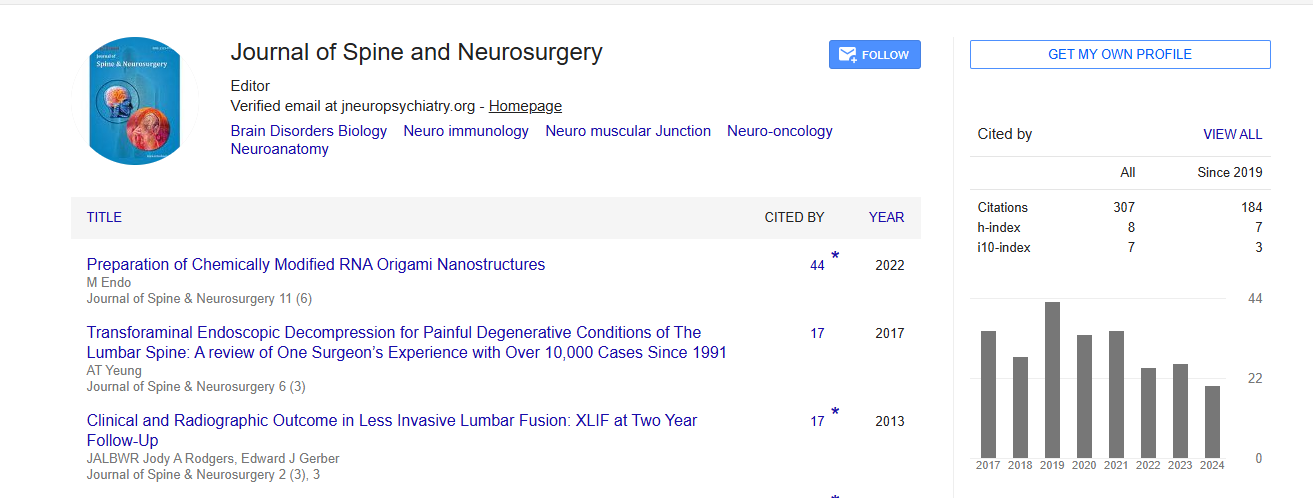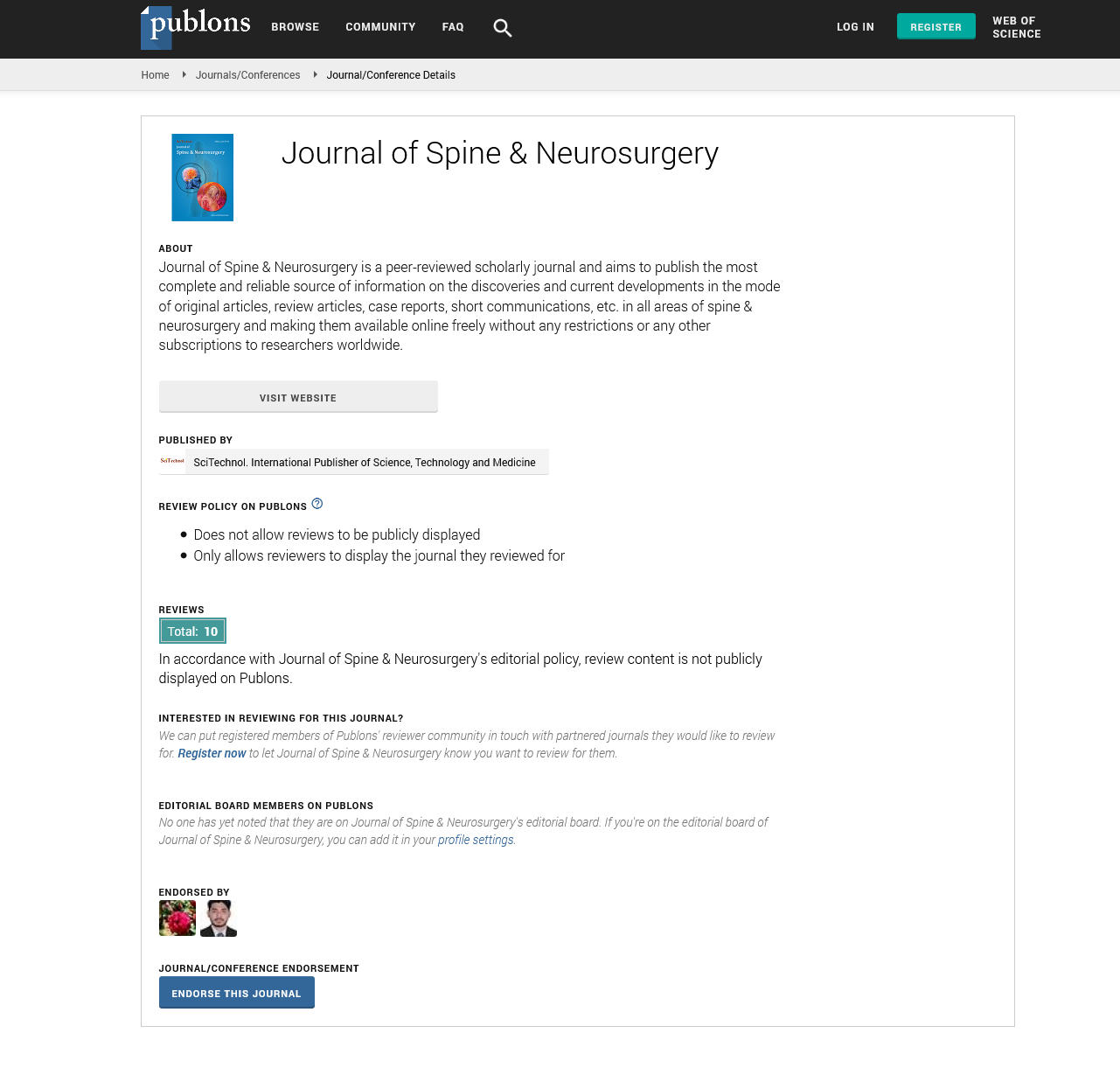Perspective, J Spine Neurosurg Vol: 12 Issue: 6
The Complexities of Neurofibromatosis: Unraveling Causes, Symptoms, and Management
Kimin Cha*
1Department of Neurology & Rehabilitation, University of Illinois at Chicago, Chicago, USA
*Corresponding Author: Kimin Cha,
Department of Neurology & Rehabilitation,
University of Illinois at Chicago, Chicago, USA
E-mail: cha_kimin@gmail.com
Received date: 27 November, 2023, Manuscript No. JSNS-24-128410;
Editor assigned date: 29 November, 2023, PreQC No. JSNS-24-128410 (PQ);
Reviewed date: 14 December, 2023, QC No. JSNS-24-128410;
Revised date: 21 December, 2023, Manuscript No. JSNS-24-128410 (R);
Published date: 28 December, 2023, DOI: 10.4172/2325-9701.1000190.
Citation: Cha K (2023) The Complexities of Neurofibromatosis: Unraveling Causes, Symptoms, and Management. J Spine Neurosurg 12:6.
Description
Neurofibromatosis (NF) is a rare genetic disorder that affects the nervous system, causing the growth of tumors on nerves throughout the body. Comprising a group of genetic conditions, neurofibromatosis can manifest in various ways, with distinct subtypes presenting unique challenges the complexities of neurofibromatosis, informative on its causes, symptoms, and current management strategies. There are three main types of neurofibromatosis: Neurofibromatosis Type 1 (NF1), Neurofibromatosis Type 2 (NF2), and Schwannomatosis. NF1 is the most common form, affecting about one in 3,000 individuals globally. NF2 is less common, occurring in about one in 25,000 people, while Schwannomatosis is the rarest subtype. Neurofibromatosis is primarily a genetic disorder caused by mutations in specific genes. NF1 is associated with mutations in the NF1 gene, while NF2 is linked to the NF2 gene. Schwannomatosis involves mutations in the SMARCB1 and LZTR1 genes. In most cases, neurofibromatosis is inherited in an autosomal dominant manner, meaning an affected individual has a 50% chance of passing the condition on to their children.
Symptoms
The symptoms of neurofibromatosis can vary widely, even within the same subtype. Common features of NF1 include cafe-au-lait spots (light-brown skin patches), neurofibromas (tumors on or under the skin), and lisch nodules (pigmented lesions on the iris). NF2 is characterized by the development of vestibular schwannomas (tumors affecting the hearing nerve) and other nervous system tumors. Schwannomatosis is distinguished by multiple schwannomas, typically affecting peripheral nerves. Neurofibromatosis can lead to various complications, including vision and hearing impairment, skeletal abnormalities, and learning disabilities. Individuals with NF1 may also have an increased risk of developing other conditions such as high blood pressure, tumors in the optic pathway (optic gliomas), and bone abnormalities. NF2 is primarily associated with the development of bilateral vestibular schwannomas, which can lead to hearing loss and balance issues.
Diagnosis and treatment
Diagnosing neurofibromatosis involves a comprehensive clinical evaluation, often requiring input from multiple specialists such as geneticists, neurologists, and ophthalmologists. Genetic testing can confirm the presence of specific mutations associated with each subtype. Early diagnosis is crucial for implementing appropriate management strategies and providing support to affected individuals and their families. Currently, there is no cure for neurofibromatosis, and treatment focuses on managing symptoms and complications. Regular monitoring through imaging studies, hearing tests, and developmental assessments helps track the progression of the condition. Surgical intervention may be considered to remove tumors causing significant impairment or discomfort. Physical therapy, educational support, and counseling play vital roles in improving the quality of life for individuals with neurofibromatosis. Ongoing research efforts aim to unravel the intricate mechanisms of neurofibromatosis and develop targeted therapies.
Conclusion
Neurofibromatosis is a complex genetic disorder that poses diverse challenges to affected individuals and their families. By delving into the causes, symptoms, and management strategies associated with each subtype, we can better comprehend the multifaceted nature of neurofibromatosis. Continued research and advancements in medical science hold promise for enhanced diagnostics and targeted therapies, offering a beacon of hope for those navigating the complexities of this rare condition. Through awareness, support, and collaborative efforts, the medical community strives to improve the lives of individuals affected by neurofibromatosis and pave the way for a brighter, more informed future. Advances in genetic research and emerging technologies offer anticipation for more precise diagnostic tools and tailored treatment options. Clinical trials are underway to explore novel therapeutic approaches, raising optimism for improved outcomes in the future.
 Spanish
Spanish  Chinese
Chinese  Russian
Russian  German
German  French
French  Japanese
Japanese  Portuguese
Portuguese  Hindi
Hindi 
